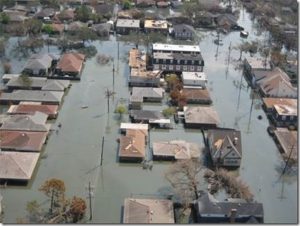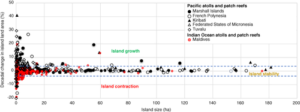by Jim Steele, February 23, 2019 in WUWT
Local sea levels appear to rise when ocean volumes increase, but also when the land sinks. Scientists increasingly warn that coastal cities are sinking much faster than ocean volumes are rising. Pumping out groundwater not only causes lands to sink, it increases the oceans’ volume. China’s Huanghe Delta is sinking 10 inches a year. Southeast Asian cities battle sinking rates of 1.2 to 2.4 inches per year. Regions around Houston, Texas had sunk 10 feet by 1979; a disaster waiting to happen where hurricanes commonly generate 15-foot storm surges. Likewise, New Orleans was doomed by sinking 1.4 inches per year. Built on marshland, San Francisco’s airport sinks 0.4 inches per year.
In contrast, ocean warming plus added glacial meltwater are estimated to have only added 0.06 inches per year to sea level from 1850 to 1990, punctuated by decades that accelerated sea level rise to 0.14 inches a year. Still, that fastest rate of modern sea level rise remains only one-tenth of New Orleans’ sinking rate.
…

by E. Duvat, October 25, 2018 in WiresClimateChange
Over the past decades, atoll islands exhibited no widespread sign of physical destabilization in the face of sea‐level rise. A reanalysis of available data, which cover 30 Pacific and Indian Ocean atolls including 709 islands, reveals that no atoll lost land area and that 88.6% of islands were either stable or increased in area, while only 11.4% contracted. Atoll islands affected by rapid sea‐level rise did not show a distinct behavior compared to islands on other atolls. Island behavior correlated with island size, and no island larger than 10 ha decreased in size.

…
by D. Rosenfeld et al., February 8, 2019 in Science
Reflections on cloud effects
How much impact does the abundance of cloud condensation nuclei (CCN) aerosols above the oceans have on global temperatures? Rosenfeld et al.analyzed how CCN affect the properties of marine stratocumulus clouds, which reflect much of the solar radiation received by Earth back to space (see the Perspective by Sato and Suzuki). The CCN abundance explained most of the variability in the radiative cooling. Thus, the magnitude of radiative forcing provided by these clouds is much more sensitive to the presence of CCN than current models indicate, which suggests the existence of other compensating warming effects.
…
La géologie, une science plus que passionnante … et diverse


